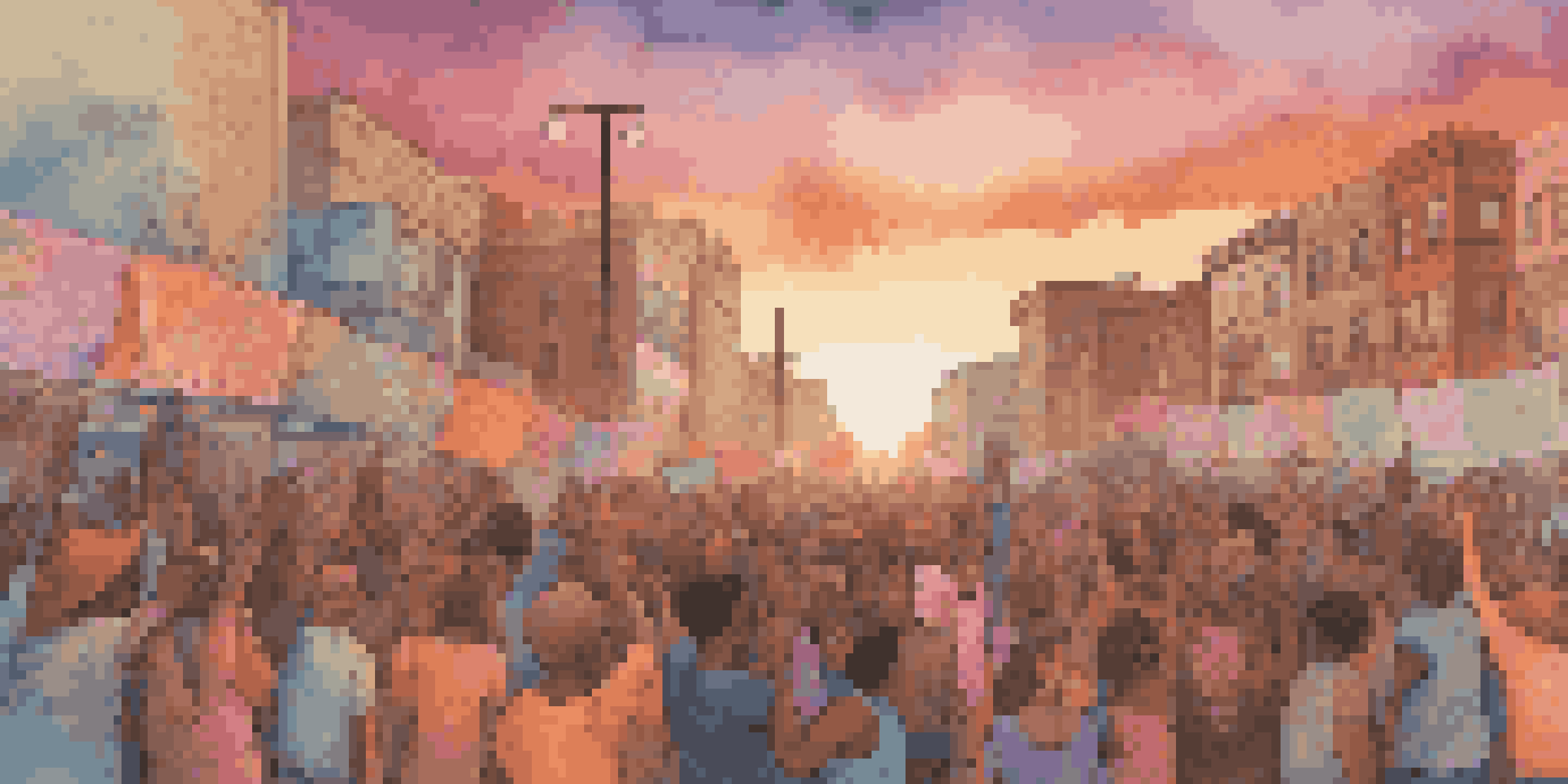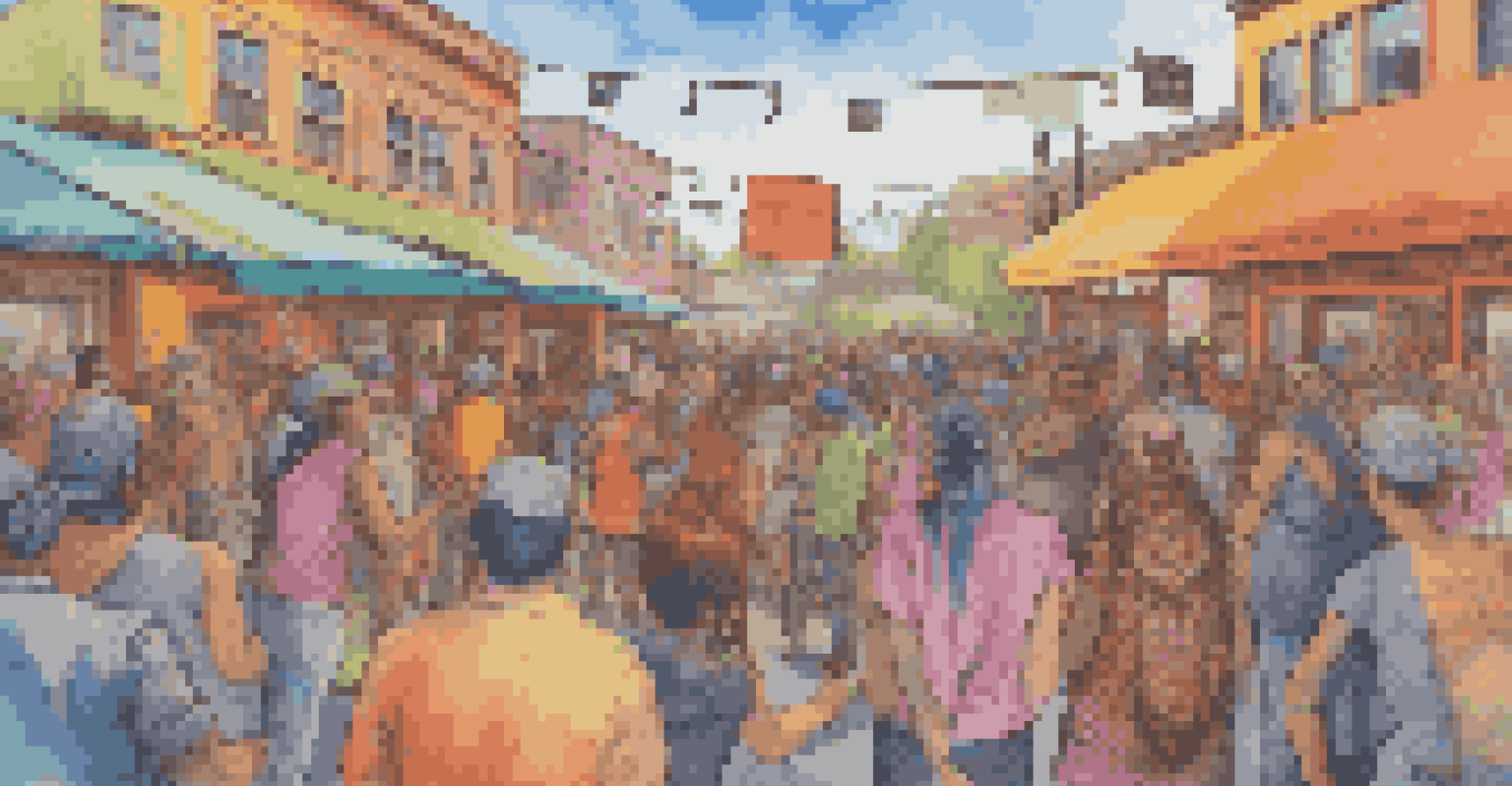The Significance of Art in Political Digital Activism

Art as a Catalyst for Political Change
Art has often been a driving force behind social and political movements, inspiring people to take action. From protest songs to powerful visual art, creative expressions can ignite passion and provoke thought. In the digital age, this influence has only grown, as art can be shared widely and instantly, reaching diverse audiences across the globe.
Art is not freedom of expression. It is freedom of expression itself.
For instance, during the Arab Spring, graffiti and street art became symbols of resistance, quickly spreading through social media. This visual language transcended barriers, allowing people to connect with the movement's core messages. Thus, art serves not only as a form of expression but also as a tool for mobilization and solidarity.
Moreover, the accessibility of digital platforms means that almost anyone armed with a smartphone can create and circulate political art. This democratization of artistic expression empowers individuals and communities to voice their concerns and aspirations creatively.
The Emotional Impact of Art in Activism
One of the most powerful aspects of art is its ability to evoke emotions. Political messages conveyed through art resonate on a deeper level than mere words, often leading to a more profound understanding of issues. When people encounter art that reflects their struggles or aspirations, it can foster empathy and solidarity.

Consider the poignant images or videos shared during movements like Black Lives Matter. These pieces often highlight personal stories and experiences, making the abstract concepts of injustice and inequality feel tangible and urgent. This emotional connection can motivate individuals to engage more actively in the cause.
Art Drives Political Movements
Creative expressions like visual art and music inspire action and mobilize communities for social change.
Additionally, art can provide a sense of hope and resilience. In times of despair, creative expressions can uplift spirits and inspire collective action, reminding individuals that they are not alone in their fight for change.
Digital Platforms Amplifying Artistic Voices
The rise of social media has transformed the landscape of political activism, allowing artists to share their work with unprecedented speed and reach. Platforms like Instagram, Twitter, and TikTok enable artists to disseminate their messages widely, often resulting in viral campaigns that capture public attention. This accessibility has given a voice to previously marginalized artists, who can now share their perspectives with the world.
The role of the artist is to make the revolution irresistible.
For example, the #MeToo movement saw countless artists share their experiences through visual art, music, and spoken word. These digital expressions created a collective narrative that not only raised awareness but also fostered a supportive community. As a result, art becomes a unifying force that connects individuals across different backgrounds and experiences.
Moreover, digital art can take on innovative forms, such as memes and animations, making political messages more relatable and engaging. This adaptability allows artists to reach younger audiences who may be more inclined to interact with content that is visually stimulating and easily shareable.
Art as a Form of Protest and Resistance
Art has a long history of serving as a form of protest, challenging the status quo and calling attention to social injustices. In the context of digital activism, this tradition continues as artists use their creativity to critique oppressive systems. Whether through satirical cartoons or powerful murals, art can convey dissent in a way that is both impactful and memorable.
During the protests against police brutality, many artists created pieces that directly addressed the issues at hand, making bold statements that resonated with the public. These artworks often serve as visual declarations of resistance, capturing the spirit of movements and inspiring action.
Digital Platforms Empower Artists
Social media allows artists to amplify their voices and share their political messages with a global audience.
Furthermore, art can also act as a means of preserving history, documenting struggles and victories for future generations. By capturing moments of resistance, artists ensure that the narratives of marginalized communities are not forgotten.
The Role of Collaboration in Artistic Activism
Collaboration is at the heart of many successful artistic activism projects. When artists come together, they can pool their talents and resources, creating more powerful and diverse works. This collaborative spirit fosters community and encourages dialogue, allowing for a richer exploration of complex issues.
For instance, many protests have featured collaborative art installations, where artists from various backgrounds create pieces that reflect collective experiences. This not only amplifies the message but also highlights the importance of solidarity in activism. By working together, artists can create art that speaks to a wider audience and embodies the spirit of the movement.
Moreover, digital platforms facilitate these collaborations, enabling artists from different parts of the world to connect and share their perspectives. This global exchange of ideas enriches the artistic landscape and broadens the reach of political messages.
Challenges Faced by Artists in Digital Activism
While digital platforms offer new opportunities for artistic expression, they also present challenges. The rapid pace of information can make it difficult for individual artists to stand out in a crowded landscape. With countless voices vying for attention, creating art that captures interest and fosters engagement can be daunting.
Additionally, the potential for censorship looms large, particularly for artists tackling sensitive political issues. Platforms may remove content deemed controversial, limiting the ability of artists to express themselves freely. This challenge highlights the importance of finding alternative spaces for sharing art, ensuring that important messages are not silenced.
Collaboration Enhances Impact
When artists work together, they create more powerful, diverse works that resonate with wider audiences.
Finally, the emotional toll of addressing difficult subjects through art can be significant. Artists often grapple with feelings of vulnerability and the weight of their messages, which can impact their mental health. It's vital for the creative community to support one another in navigating these challenges.
The Future of Art in Political Digital Activism
As technology continues to evolve, so too will the role of art in political digital activism. Emerging technologies, such as virtual and augmented reality, offer new avenues for immersive artistic expression that can engage audiences in innovative ways. These advancements could transform the way political messages are conveyed, making them more interactive and impactful.
Additionally, the growing emphasis on social justice and equity in political discourse suggests that art will remain a crucial tool for advocacy. As society grapples with complex issues such as climate change, racial inequality, and human rights, artists will likely play an essential role in shaping narratives and inspiring action.

Ultimately, the future of art in political activism is bright, filled with potential for creativity and collaboration. As artists continue to push boundaries and challenge perceptions, they will undoubtedly remain at the forefront of movements for change, using their craft to influence hearts and minds.